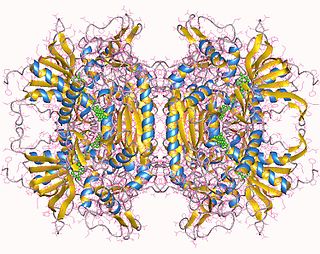Related Research Articles
Cysteine metabolism refers to the biological pathways that consume or create cysteine. The pathways of different amino acids and other metabolites interweave and overlap to creating complex systems.
Aspergillopepsin I is an enzyme. This enzyme catalyses the following chemical reaction
Cathepsin T is an enzyme. This enzyme catalyses the following chemical reaction: Interconversion of the three forms of tyrosine aminotransferase, EC 2.6.1.5.
In enzymology, a 7alpha-hydroxysteroid dehydrogenase (EC 1.1.1.159) is an enzyme that catalyzes the chemical reaction

In enzymology, a pyranose oxidase (EC 1.1.3.10) is an enzyme that catalyzes the chemical reaction
Cathepsin X is an enzyme. This enzyme catalyses the following chemical reaction
NADH dehydrogenase is an enzyme that converts nicotinamide adenine dinucleotide (NAD) from its reduced form (NADH) to its oxidized form (NAD+). Members of the NADH dehydrogenase family and analogues are commonly systematically named using the format NADH:acceptor oxidoreductase. The chemical reaction these enzymes catalyze is generally represented with the following equation:
Endo-1,3(4)-β-glucanase -β-D-glucan 3(4)-glucanohydrolase) is an enzyme with systematic name 3(or 4)-β-D-glucan 3(4)-glucanohydrolase. It catalyses the following chemical reaction
Sucrose α-glucosidase is an enzyme with systematic name sucrose-α-D-glucohydrolase. It catalyses the hydrolysis of sucrose and maltose by an α-D-glucosidase-type action.
Aminopeptidase I is an enzyme. This enzyme catalyses the following chemical reaction
Peptidyl-glycinamidase is an enzyme. This enzyme catalyses the following chemical reaction
Cerevisin is an enzyme. This enzyme catalyses the following chemical reaction
Lysyl endopeptidase is an enzyme. This enzyme catalyses the following chemical reaction
Glycyl endopeptidase is an enzyme. This enzyme catalyses the following chemical reaction
Mucorpepsin is an enzyme. This enzyme catalyses the following chemical reaction
Serralysin is an enzyme. This enzyme catalyses the following chemical reaction
Peptidyl-Lys metalloendopeptidase is an enzyme. This enzyme catalyses the following chemical reaction
Peptidyl-Asp metalloendopeptidase is an enzyme. This enzyme catalyses the following chemical reaction
Trimerelysin II is an enzyme. This enzyme catalyses the following chemical reaction

The sedolisin family of peptidases are a family of serine proteases structurally related to the subtilisin (S8) family. Well-known members of this family include sedolisin ("pseudomonalisin") found in Pseudomonas bacteria, xanthomonalisin ("sedolisin-B"), physarolisin as well as animal tripeptidyl peptidase I. It is also known as sedolysin or serine-carboxyl peptidase. This group of enzymes contains a variation on the catalytic triad: unlike S8 which uses Ser-His-Asp, this group runs on Ser-Glu-Asp, with an additional acidic residue Asp in the oxyanion hole.
References
- ↑ Remold H, Fasold H, Staib F (October 1968). "Purification and characterization of a proteolytic enzyme from Candida albicans". Biochimica et Biophysica Acta (BBA) - Enzymology. 167 (2): 399–406. doi:10.1016/0005-2744(68)90219-2. PMID 5729955.
- ↑ Rüchel R (May 1981). "Properties of a purified proteinase from the yeast Candida albicans". Biochimica et Biophysica Acta (BBA) - Enzymology. 659 (1): 99–113. doi:10.1016/0005-2744(81)90274-6. PMID 7018586.
- ↑ Negi M, Tsuboi R, Matsui T, Ogawa H (July 1984). "Isolation and characterization of proteinase from Candida albicans: substrate specificity". The Journal of Investigative Dermatology. 83 (1): 32–6. doi: 10.1111/1523-1747.ep12261656 . PMID 6203988.
- ↑ Lott TJ, Page LS, Boiron P, Benson J, Reiss E (February 1989). "Nucleotide sequence of the Candida albicans aspartyl proteinase gene". Nucleic Acids Research. 17 (4): 1779. doi:10.1093/nar/17.4.1779. PMC 331855 . PMID 2646602.